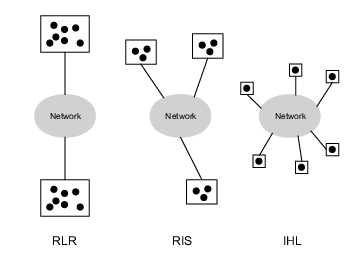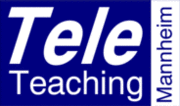General Description
The TeleTeaching projects of the University of Mannheim are (or were) supported by:
Motivation
Instruction at universities in Germany is generally very traditionally oriented. Types of instruction are typically didactic teaching, seminars, or tutorials where as means of knowledge transfer blackboard and overhead projector are used; sometimes analogue videos or slides. Advances in multimedia technologies and high speed networks lead to new types of instruction. Different digital media may be now integrated and distributed via networks, such that they are available in arbitrary places and at arbitrary times (independency of place and time). Moreover, these media provide new types of presentation of contents, which can increase both clearness of complicated subject matter and motivation. Intelligent tutoring programs promote individualized learning, e.g. by adjusting learning speed or difficulty. Teleteaching denotes the spatial distribution of teachers and students who are connected via fast computer networks and who communicate synchronously or asynchronously for learning purposes. Compared to traditional distance learning this allows for a higher degree of interactivity and usage of new instructional media such as digital animations or simulations. The new technologies are very promising in eliminating the disadvantages of traditional distance learning by combining the advantages of both face-to-face instruction and distance education.
Background
The Universities of Mannheim and Heidelberg are situated an hours drive from each other, students have always had to commute in order to gain a sound education in their fields of studies. In 1995, the two universities have formally agreed to intensify cooperation in both research and education, e.g. through the sharing of facilities and mutually accepting students' credits. Students of the newly founded course of studies 'Technical Computer Science' in Mannheim need to take courses in physics which are not provided by Mannheim but by Heidelberg. Vice versa Heidelberg has no faculty for Computer Science. This has provided the organizational basis for a semi-virtual university in which courses will consist of both local and remote (by means of telecommunications) lectures, seminars, workshops, and student cooperative work groups. As a consequence in 1995, the project TeleTeaching Mannheim-Heidelberg has been founded in order to investigate organizational, pedagogical and technical issues of a semi-virtual university.Meanwhile, the teleteaching activities include the Universities of Freiburg, Karlsruhe, Heidelberg and Mannheim. Since 1998 the virtual university VIROR (Virtuelle Universität Oberrhein) provides synchronous and asynchronous learning modules to its partner universities.
Scenarios
The project basically supports three instructional settings that are realized through multimedia and telecommunication technology. The scenarios are characterized by their scope of distribution, interactivity and individualization of the learning process as indicated in the following figure.

Remote Lecture Room (RLR)
In the Remote Lecture Room scenario, large lecture rooms are connected via a high speed network such as ATM. Each lecture room is equipped with state-of-the-art audio and video technologies and one high performance multimedia workstation. Typically, interactivity should be low and the consumption of knowledge would tend to be more passive. Lectures that are part of the common course of studies of the participating universities are exchanged synchronously between the lecture rooms. The transmission runs in an interactive mode and we are using the following streams of information:
- The teacher's video and audio stream: captured by a local camera and a microphone, these are connected to the workstation. The signals are then digitized, transmitted to the remote lecture room, and the video is projected by a large-scale video projector.
- The local student's video and audio stream: are dealt in the same manner, namely the remote students are also able to receive the local student's video. Because of this the remote students become more involved, getting the feeling of sitting in a large, virtual classroom.
- The remote student's video and audio stream are transmitted vice versa.
- Electronic transparencies of the teacher and other course materials such as animations, simulations, graphics and digital videos are transmitted also by using an electronic whiteboard and/or shared tools.
In this concept, the lecture rooms merge in to one large, virtual room wherein all students have the same learning experience.
Remote Interactive Seminars (RIS)
RIS describes a more interactive type of instruction. Small groups of participants are distributed across a few seminar rooms which are also connected by a network. The main goal in a seminar is to become more familiar with a specific topic, hence, groups of students have to formulate a small report about a certain topic which has to be presented in the seminar. This kind of learning includes two types of communication:
- asynchronous: during the formulation of the report students use e-mail or newsgroups to interact with each other.
- synchronous: students are using video conferencing systems to transmit their presentation to the remote groups and use CSCW tools for their group work.
RIS focuses mainly on the cooperative, on-line construction and presentation of reports. The equipment of the seminar rooms is comparable to the RLR module if somewhat less lavish.
Interactive Home Learning (IHL)
The IHL module is aimed at the maximization of the geographical distribution degree of all class participants. Each student learns at home in front of his or her PC asynchronously as well as synchronously. The teacher and the students are connected by low-bandwidth links (e.g. ISDN) or by high-bandwidth XDSL connections. Asynchronous learning comprises of the retrieval of recorded lectures, lecture notes, work with CBT software and case studies and the participation in electronic discussion groups. In the synchronous mode students should be able to participate interactively and live, in lectures, in seminars and in training courses whilst being at home. The major goal of IHL is the achievement of better preparation for exams and a further intensification of co-operative learning.
Technical Realization
We are using MBone video conferencing tools and the Internet for remote lecturing. To ensure an acceptable audio and video quality, a virtual LAN based on ATM PVCs connects the Universities of Freiburg, Karlsruhe, Heidelberg and Mannheim. Moreover, lectures are sent to the remainder of the german Internet by using multicast technologies. Besides the standard MBone tools, we are using our own software products for computer-based distance education such as, for instance, the VCRoD recording system, distributed Java-based animations, the digital lecture board, and 3D telecooperation tools.
Research Directions
Research in the context of teleteaching at the University of Mannheim comprises all flavors of computer-based distance education, i.e. technical, organizational and pedagogical issues. The Department for Applied Computer Science IV (Lehrstuhl Praktische Informatik IV) at the University of Mannheim mainly covers technical issues. Areas of interest are multicast, reliability, multimedia computing, CSCW, groupware, telecooperation, interactive applications, network and application-level protocols, digital libraries etc.
Publications
For publications about specific research topics please have a look at the corresponding project activities. Some more general publications about the TeleTeaching project are listed below:
W. Effelsberg: Das Projekt TeleTeaching der Universitäten Heidelberg und Mannheim. In: PIK 18 (1995) 4, K.G. Saur Verlag, München, 1995.
W. Effelsberg, W. Geyer and A. Eckert: Project TeleTeaching Mannheim - Heidelberg. In: Proc. 21st Annual Conference of the Society for Classification e.V., University of Potsdam, Germany, March 1997.
A. Eckert, W. Geyer and W. Effelsberg: A Distance Learning System for Higher Education Based on Telecommunications and Multimedia. In: Proc. ED-MEDIA'97, World Conference on Educational Multimedia and Hypermedia, Calgary, Canada, June 1997.
W. Effelsberg, W. Geyer: Tools for Digital Lecturing - What We Have and What we Need. In: Proc. BITE'98, Bringing Information Technology to Education, Maastricht, Netherlands, March 1998.
W. Geyer, A. Eckert and W. Effelsberg: Multimedia in der Hochschullehre - TeleTeaching an den Universitäten Mannheim und Heidelberg. In: Studieren und weiterbilden mit Multimedia, Reihe Multmediales Lernen in der Berufsbildung, BW Bildung und Wissen Verlag, Nuernberg, 1998, pp. 170-196.


